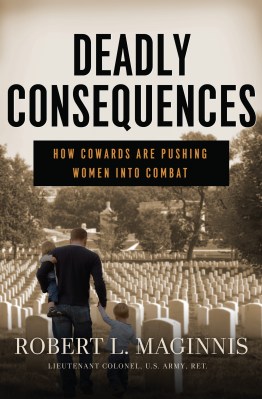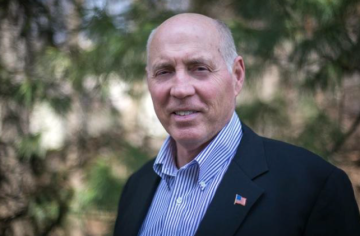Female Marine recruits ready for pugil stick training earlier this year at Parris Island, S.C.
Earlier this year, the Pentagon lifted the ban on women serving in U.S. combat units – including elite special-operations units like the Navy’s SEALs – if they can clear the physical and mental hurdles. While official Washington has saluted and moved on to other matters, there remains a rumble of opposition, especially evident when chatting with soldiers and Marines. Some argue that the existing standards – which already have kept several women from passing the Marines’ grueling infantry officers course – will basically act as a bar to women in the more demanding kinds of combat.
But Robert Maginnis, a retired Army lieutenant colonel and West Point graduate, fears that won’t happen. He spells out what he sees as the dangers of opening combat billets to women in his new book, Deadly Consequences: How Cowards Are Pushing Women into Combat. His key concern is that, under political pressure, the military will ease its standards, resulting in a less-capable force. Battleland recently conducted this email chat with him.
What’s the key thing you learned in writing Deadly Consequences: How Cowards Are Pushing Women into Combat?
Pentagon brass are kowtowing to their political masters and radical feminists to remove exemptions for women in ground combat in defiance of overwhelming scientific evidence and combat experience.
This craven behavior is terribly dangerous for our armed forces, our national security, and especially the young women who will be placed in harm’s way.
Pentagon officials insist they won’t lower standards to enable more women in combat units. Do you believe them?
I don’t believe them, and neither should the American people.
The Obama Administration and the Pentagon say they will maintain high standards “to ensure that the mission is met with the best-qualified and most capable people, regardless of gender,” in the words of former Secretary of Defense Leon Panetta.
Personnel policy, however, is driven by the “diversity metrics” outlined in the 2011 Report of the Military Leadership Diversity Commission.
Diversity, not military readiness, is the highest priority.
General Martin Dempsey, chairman of the Joint Chiefs of Staff, has admitted as much. In the press conference announcing the rescission of the 1994 rule excluding women from ground combat units, he said, “If we do decide that a particular standard is so high that a woman couldn’t make it, the burden is now on the service to come back and explain to the secretary, why is it that high?”
The proper question is “Do we have the personnel we need to meet the current high standards for combat units?”
The answer right now is yes.
There is no shortage of able-bodied male volunteers who meet the existing, battle-tested standards for ground combat positions.
So why ask the services to consider changing the standards? Because this has become more about politics than fielding the most capable fighting force.
What do you see as the three biggest risks to letting women serve in the combat arms?
There are a multitude of risks—far more than most people realize, especially those without military experience. Among the many risks I discuss in “Deadly Consequences” are these three:
— First, standards will be lowered. As a practical matter, there has to be a certain minimum number of women in combat units for the policy to succeed. That can be accomplished only by “gender norming” the standards for combat service. Lower standards will inevitably degrade combat effectiveness, and the nation will be less secure. There is also good evidence that the policy will harm military recruitment and retention.
— Second, women who serve as ground combatants, whether by choice or under compulsion, will suffer disproportionate physical and psychological harm.
— Third, the already serious problem of sexual assault in the military will get worse. Notwithstanding the Administration’s wishful thinking, this prediction is borne out by the statistics.
What do you think will happen, given the push to let women serve in combat, if the nation ever needs to reinstitute the draft?
Lifting all combat exclusions for women virtually guarantees that the Supreme Court will declare male-only conscription unconstitutional.
And a return to the draft is far more likely than most people realize. The unsustainably high cost of the all-volunteer force, especially with $17 trillion in national debt, and the expected requirements of future military operations will probably lead to a resumption of the draft, however politically unpopular it might be.
When that happens, women will be drafted and forced into ground combat roles.
The Joint Chiefs of Staff endorse the idea of women serving in combat. Are they the “cowards” you refer to in your subtitle?
They demonstrate a cowardice of silence because they know better. The scientific evidence and the lessons of combat experience are utterly one-sided: women are unsuited for ground combat service.
Congress has the constitutional responsibility to set the rules and regulations governing the armed forces (Article I, Section 8).
Unfortunately, Congress is as cowardly as the Joint Chiefs.
Putting women in combat is as historic a change of military policy as anything I can think of, yet neither house has held full hearings on the question in over 20 years.
The politicians are running scared.
You said letting openly gay men and women serve in uniform would be a disaster, and likely lead to problems with recruiting and retention. None of that has come to pass. So why should we pay attention to your arguments about women in combat?
It is much too early to assess the effects of open homosexuality in the military.
The Pentagon has not released any external or internal surveys on recruiting and retention since “don’t ask, don’t tell” was repealed. The Pentagon survey conducted prior to the repeal demonstrated substantial opposition within the ranks, which continues today.
What we do have is the Pentagon-sponsored 2013 Sexual Assault Prevention & Response Office survey, which found a giant increase in unwanted male-on-male sexual contact since the repeal.
According to the New York Times, 13,900 active-duty men and 12,100 active duty women said they had experienced unwanted sexual contact in 2012, the first full year after repeal of the homosexual ban.
The proportion of female victims is much higher, of course, but the Pentagon obviously has a serious problem with male-on-male sexual assaults.
Is there cause and effect here or merely correlation?
It is too early to say, but there is certainly no basis for declaring the new policy on homosexuality a success.




